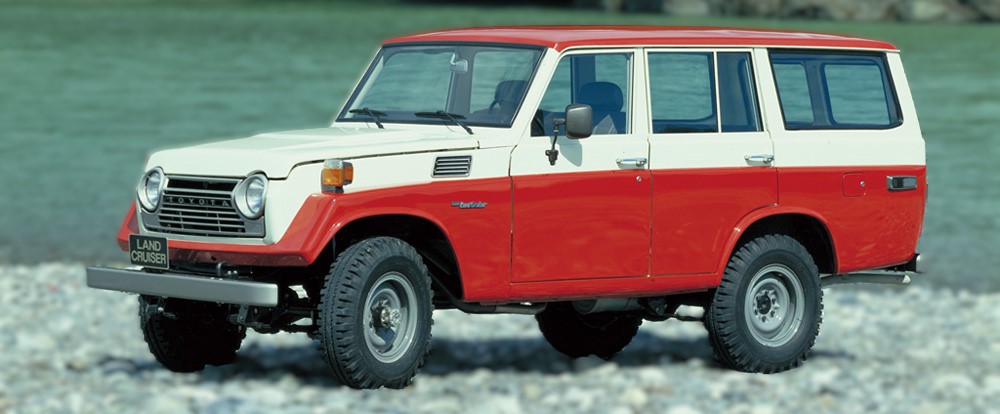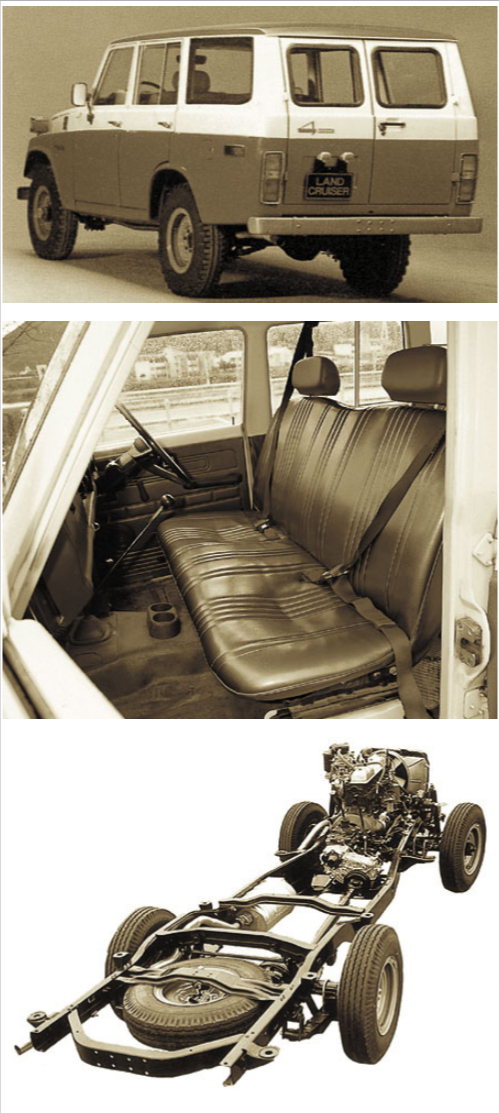
Appearance of the First Real Station Wagon
The 40 series had three different body lengths all with the same face as uniqueness is a necessity for a utility vehicle with typical users that desire a sense of prestige. That was the reason why the long body FJ55V was given an exclusive vehicle body.
In 1967 the FJ45V was replaced with the FJ55V, which had a 2,700mm wheelbase. The Land Cruiser made its appearance as a cross-country type 4×4 vehicle, but the market had begun to accept the idea that it also could be a utility vehicle for carrying things. For that reason the demand increased for a vehicle with a larger body that could carry more people and more cargo.
Toyota’s response to this demand was to build wagons like the FJ35V and FJ45V. After that the demand became strong for a real station wagon. If all you need is a vehicle to carry people or cargo, an ordinary truck can do the job. However, even if you traveled to a work site by road, once the work was done the Land Cruiser was often expected to cross ground where there was no guarantee that the roads would be passable. Depending on the weather conditions the road might wash out or become submerged under water. It was for conditions like this that people selected a Land Cruiser.
It is often assumed that all Land Cruisers were assembled at the Arakawa Auto Body Co., Ltd. (now Toyota Auto Body Co., Ltd.), but actually the long wheelbase versions such as the FJ35V and FJ45V were made at the Gifu Auto Body Industry Co., Ltd. At that time there were orders from overseas for trucks that could carry 7 to 9 people, and the demand was rising for a wagon type vehicle. Plans for a wagon design were pursued with the assumption that it would be built at the Arakawa Auto Body Co., Ltd.
However, as Toyota had out a priority on development of passenger cars such as the Crown and the Corona, the Toyota design staff was too busy to be free to work on the Land Cruiser. As a result, up through the 40-series, the design was handled by on site technical staff working with little more than rulers and compasses. However, from the 50-series on, at last designers were again free to pay serious attention to the Land Cruiser, creating serious design sketches and clay models.
Leaving some traces of the original 40-series, they added a brand new branch to the Land Cruiser tradition and created the FJ55V. The body size was larger than that of a compact car, the ride was as comfortable as a passenger car, and it was designed not just for utility but also for leisure use. It was designed to be able to cruise at 130km/h, in view of the high-speed highways in America. It was also designed tough, to withstand the rugged treatment it was expected to get on the Australian landscape, and it was the first time that a Toyota truck was built entirely with fully enclosed box cross-section welded members. Already at this time it was engineered to meet American safety standards established through frontal crash testing at speeds of 50km/h, and all of these improvements strengthened the design of the vehicle.
It was at this time that the Honda N360 became a big hit. The Toyota 2000GT, Cosmo Sport, and other genuine sports cars appeared, and for the first time Japan’s domestic annual automobile production exceeded 10,000,000 units, making Japan the second largest automobile producing nation in the world. In 1975 the F-type engine underwent further improvements, becoming the 2F-type 4.2-liter engine, which was installed in the newly debuted FJ56V. The 2F-type engine had a piston displacement of 4,300cc, an output of 140PS/3,600rpm and torque of 30kgm/1,800rpm. The FJ55V had a 3-speed transmission, while the FJ56V had a 4-speed transmission. In addition, the hood design was made rounder, the triangular-shaped window was eliminated, the signal indicator was integrated into the car side lamps, and other small changes were made, but the basic design remained unchanged.
The 50-series was made to be sold on the great continents of America and Australia, and because of its shape, in America it was affectionately known as the Moose.
The FJ55V was the successor to the FJ45V, and was a full model change bearing little in common with its predecessor. Everything on the chassis except of the axel was completely redesigned. When the frame evolved from the 20-series to the 40-series the number of fully enclosed box cross-section members increased in the side frame, but in the FJ55V all of the remaining open-ended members were replaced with fully enclosed members. Moreover, the member assembly method was changed from riveting to welding.
As a result on the FJ55V frame the wheelbase was extended by 50mm, lengthening the rear overhang, and for improved productivity assembly was divided into 3 phases. Ordinarily this kind of reinforcement would be expected to add to the vehicle weight, however even while increasing the bending strength by 20% Toyota managed to actually reduce the vehicle weight by over 10kg. The FJ55V model also had a different length in the front of the frame depending on whether or not a winch was to be installed, a station wagon design that was fully ready for the new era.
FJ55V engine was essentially the same F-type engine as the FJ45V that had been used in the 40-series, however there were significant improvements made particularly in the cylinder heads. The reason for this was to raise the rpm level at which the engine produced its maximum output, aiming at better performance in high speed driving, and also improvements were made to reduce emissions.
On the new cylinder heads of the F-type engine the position of the bolt-holes that fixed the heads to the blocks was the same, but the shape of the heads was completely different. The combustion chamber had the same wedge shape, but the angles of the intake and exhaust valves were both fixed at 6-degrees, the shape and numbers of the rocker arms were modified, and the entire unit was made lighter. A passenger car use compact 4-cylinder 2R-type gasoline engine camshaft was added to improve intake efficiency at high rpm levels.
With the FJ56V the engine evolved from the F-type to the 2F-type, with most of the changes centering on the specs for the piston displacement and the carburetor. The cylinder bore was increased by 4mm to gain more piston displacement, and improvements were made to part of the fuel delivery system, resulting in a power boost of 10PS.
The instrument panel gained a resinous pad to protect passengers in the event of a collision. The meters were made more reliable with print layout in the wiring, the water temperature gauge used a thermistor, and the meters were made more durable.
The FJ55V had a bench-type seat in the front that could hold 3 people, but on the FJ56V you could chose a separate seat type. One feature of this series was that it had a design more like a passenger car, but at the same time was built even stronger.
The rear gate came in two types, either a fold down type or one that opened out from the center. The rear gate could only be opened after you lowered the gate window electronically, and this could be done by remote control from the driver’s seat.
The second seat was possible to fold down forward. The 55-type was designed very much with a passenger car in mind, however it sacrificed none of the Land Cruiser performance. The luggage room was flat, and from the floor to the seatbacks was all made of steel.
The rear gate type that opened out from the center could open out to a full 90 degrees, which was convenient for loading and unloading luggage. The rear combination lamp was arranged vertically and put on the lower side of the body in the FJ56V. The square lamp that is mounted a bit higher than the waistline was the design for the FJ55V.
The F-type was based on the F-type engine from the 40-series, but with improvements in the shape of the combustion chamber, intake ports, and intake manifold, as well as the addition of an exhaust cleaning apparatus.
The FJ56V had a body type that was only produced for sale in Japan, but the vehicles for export took on the 2F-type engine instead of the F-type, and also took on the name FJ55V. There are many differences in the outside appearance of the FJ56V and the FJ55V, with the FJ56V having a larger bulge in the engine hood, as well as the same combination lamp parts as used in the 40-series, but with the triangular windows abolished.
The front axle used a Birfield type ball joint, had an increased steering angle, and used truck leaf springs that were the same as those used on the Toyoace and Stout. The rear axle had many parts in common with the FJ45V.
The FJ55V was the first Land Cruiser to use a box-type enclosed structure for the side frame. It had a reduced number of cross members, making room for the drive train mechanisms. With just 3 cross-members, the front bumper and transmission under cover served as double function as substitute cross-members, thereby increasing the overall strength of the frame.


You must be logged in to post a comment.